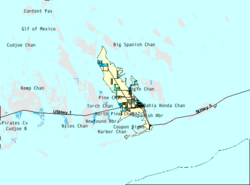2000 census
As of the census [4] of 2000, 5,032 people, 2,247 households, and 1,420 families resided in the CDP. The population density was 198.9/km2 (515.3/mi2). The 3,153 housing units averaged 124.6/km2 (322.9/mi2). The racial makeup of the CDP was 94.83% White, 1.09% African American, 0.50% Native American, 0.58% Asian, 0.02% Pacific Islander, 1.19% from other races, and 1.79% from two or more races. Hispanics or Latinos of any race were 6.72% of the population.
Of the 2,247 households, 41.4% had children under the age of 18 living with them, 43.8% were married couples living together, 5.7% had a female householder with no husband present, and 6.8% were not families. About 26.0% of all households were made up of individuals, and 7.8% had someone living alone who was 65 years of age or older. The average household size was 2.21 and the average family size was 2.63.
In the CDP, the population was distributed as 16.8% under the age of 18, 4.3% from 18 to 24, 30.3% from 25 to 44, 33.7% from 45 to 64, and 14.9% who were 65 years of age or older. The median age was 44 years. For every 100 females, there were 110.4 males. For every 100 females age 18 and over, there were 111.6 males.
The median income for a household in the CDP was $44,514, and for a family was $47,639. Males had a median income of $31,552 versus $28,021 for females. The per capita income for the CDP was $23,169. About 5.6% of families and 9.5% of the population were below the poverty line, including 17.4% of those under age 18 and 7.0% of those aged 65 or over.







